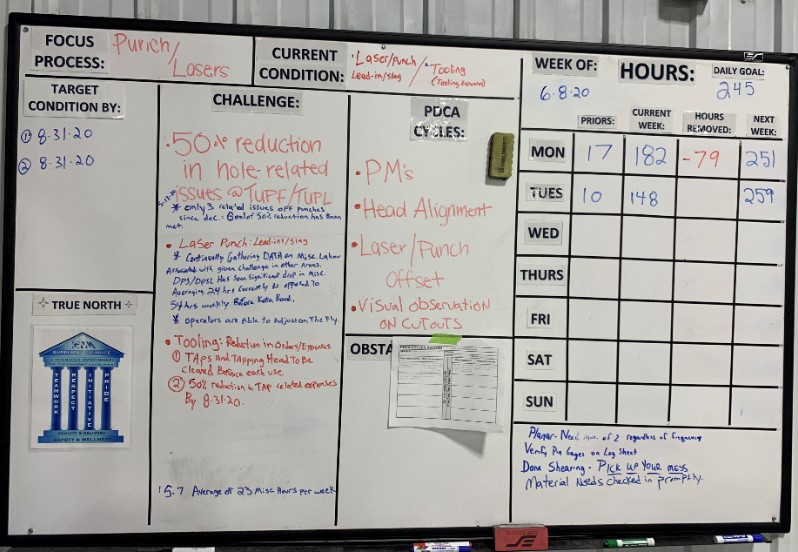We call it continuous improvement because we continually want to improve in small increments. Unlike a sport, there is no time limit and you don’t keep score. Continuous improvement is not a race and you are never done. Sometimes you’ll want to focus on specific items to improve every day with Kata.
What are some examples? Quality is one. I’ve worked with companies that had nagging quality issues they wanted to eliminate. I coached them to begin using the Kata method to attack these issues and several months later they made 90%+ improvements.
What is a Kata? The word Kata- roughly translated means “way of doing.” If you have taken any martial arts, you learn something call forms. These forms are the basis for learning the movements you need to deploy the martial arts. Think wax on, wax off in the Karate Kid. Practicing the forms is called Kata.

How do you use Kata in real-life?
There are two types of Kata, a coaching Kata and an improvement Kata. I’m going to focus on the improvement Kata in this blog.
Let’s learn how to deploy this methodology.
1. Understand what you want to improve
This is your process focus. While this may sound easy, it’s important not to choose an area or process that is too large. 5-ton press mis-alignment is better than press mis-alignment. It focuses you upon a specific process.
2. Where are we?
This is the current condition. Ask questions like how often does this occur? How much is it costing you? How many defects are being generated? It may take some time to quantify the current condition. Make sure you take your time to gather the information.
I like to focus on the 80/20 rule. What are the 20% of the defects that are causing 80% of the defects? This is a great starting point.
3. What is the challenge?
Here you are establishing the improvement parameters. Chances are, you won’t eliminate 100% of the defects within a certain time frame. If it was that easy, you would have done it years ago. Maybe you hope to eliminate 50% of the hole related issues off a certain piece of equipment.
It could be to reduce customer churn by 25%. It could be to improve first call handling of a customer by 45%. The important thing is you are trying to quantify the improvement for the first round of Kata activities.
4. How long are you going to conduct the Kata for this process?
By having a time frame for experimentation, it drives a sense of urgency. The number of improvement cycles you conduct depends upon how long the process takes to run. If you are developing cells for bio-technology your cycles could be weeks. If you are stamping parts, your process could be seconds.
Take this information into account when you set your time frame for conducting your Kata cycle.
5. PDCA Cycles
PDCA means plan, do, check, act. It comes from Edward Deming, a famous quality guru and is called the Deming wheel, or Deming cycle.
These are the steps you want to follow when trialing your Kata experiments.
Plan- what is the plan for collecting data from the process? What are the experiment parameters? What settings are you going to use? All of this and more needs to be understood before you begin an experiment.
Do- Conduct the experiment.
Check- Collect and analyze the data. What does it tell you? Did you get the result you were expecting?
Act- Plan the next round of experiments using this methodology.
6. Obstacles and parking lot
We want to capture any obstacles that prevented us from performing the experiment. Did equipment break down? Was there an interruption to the process? Did employees not show up to work? Capture any obstacles that keep you from completing the experiments.
Parking Lot- Did you learn something during a Kata experiment that you want to try later? Capture the idea so you don’t forget about it. Put these ideas in a parking lot.
7. Use a Kata board
Putting this information on a board in the department or area keeps the process in front of everyone. Review the information during your morning huddles. Take a few minutes to answer questions and review what you’ve learned.
Quickly brainstorm new ideas based upon what you have learned. This board can be combined with other boards such as performance boards, etc.
8. Frequency
It’s important not to get lost in what you want to accomplish. Yes, it can be a daily problem-solving method. Chances are though, you won’t need to improve every day with Kata. Don’t get concerned over that. Especially when you are beginning.
Follow the process, schedule your experiments to learn, and repeat. If you do this, you will improve every day with Kata!
It is an honor to serve you, and I hope that you and your company are getting better every day!
Follow me on Twitter
Join me on LinkedIn
Listen to the podcast here
